The Search for Eternal Peace, 13th – 21st May 2009
On every trip I’ve made to Russia to photograph wooden churches I’ve kept one image in my minds eye – Levitan’s extraordinary painting Above Eternal Peace. The blurb at the Tretyakov Gallery where it hangs describes it vigorously – ‘A boundless water expanse of nearly cosmic dimensions embracing an islet with a defunct chapel and neglected cemetery, brings to mind the grandeur and eternity of the Universe, the smallness of man the brevity of life.’ In fact on close inspection it seems the church is not defunct, a tiny light glows from a tiny window. At Kondoberezhnaya on Lake Onega I found the chapel, I found the sky, I found the lake but however much I twisted and turned to contrive the image in the viewfinder the various elements refused to come together. I had to settle for a photograph of the sky, the chapel, a sliver of lake and in the foreground a washing line hung with woollen tights, shirts and towels, with a whittled model aeroplane weather vane atop the pole at one end of the line, it’s propeller turning in the breeze – Below Eternal Domestic Chores.
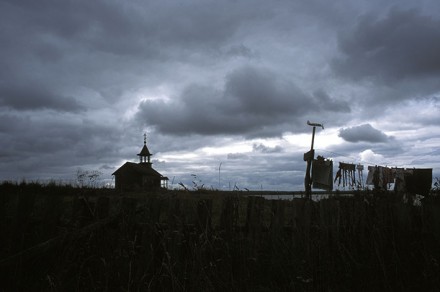
Kondoberezhnaya Aug 2003
Averil King’s beautiful book Isaak Levitan Lyrical Landscape gave me the clue I was looking for ‘the summer of 1893 saw Levitan working near Lake Udomlya at Vyshni Volochek. This visit resulted in the composition of the picture he considered to be his greatest work Above eternal rest, which he finished the following year’.
The search starts from the small flat of a Moscow friend, Polina who lives on the 16th floor of one of the seven gigantic Stalin wedding cake towers that dominant the Moscow skyline. Vysotkana Kotelnicheskaya sky scrapes beside the Moscow river. We leave later than hoped at 9.30pm pausing briefly in her kitchen to watch the sun dip behind the Kremlin.
The traffic that we hoped would have cleared is still bad. We crawl slowly from Moscow on the old Vladimirska Road, now the M7. This road was famously painted by Levitan in 1892. Again to quote Averil King ‘the ancient road formed the route taken by generations of prisoners……… Levitan started as he recognised the road, calling to mind âthe many unfortunate souls who trod the road, clanging their chains, on their way to exileâ….. It is a picture filled with sadness and foreboding……’ The road is now filled with huge articulated trucks and the infamous Moscow black painted four-wheel drive spiv wagons. After an hour the traffic begins to move, a very bad accident on the opposite carriageway had stunned the traffic to a mournful procession.
Roadside selling is big in Russia, dried mushrooms on strings, berries in buckets, preserved beetroot in bottles etc. are the norm but a dozen floodlit stalls selling metre high fluffy pink bunny rabbits with 1 ft long floppy ears in tightly sealed clear plastic bags is strangely shocking. Polina while no doubt musing on this bizarre phenomenon drove through an amber light on the outskirts of Vladimir and was flagged down and dragged off to be questioned by a policeman. On this occasion she refused to bribe the officer and was duly issued with a writ to pay a fine of 700 roubles within a month. Itâs around midnight so we stop at a night-club in Vladimir for a coffee and to catch up with the semi-final results of the Eurovision song contest while laser lights explode on a medieval brick vaulted ceiling.
The sky is clear and full of stars, mist is settling in over the fields as the sky brightens in the east – we arrive at our b&b Private Visit in Plyos at 4 am to be greeted by sleep deprived but still smiling Natalia. We look down on the glowing Volga. The early morning is alive with birdsong.
Late breakfast (Zavtrak) – Toplonoye moloko – Bliny – Tvorog – Syrniki – Oladyi – and a small lidded bowl of delicious porridge sprinkled with tiny pieces of strawberry.
At the I.I.Levitan Memorial House-Museum on the embankment we meet Olga Viktorovna Nasedkina (Olga by the Volga) the director of the Museum and her two colleagues Olga and Larisa. Over tea and biscuits (a bottle of Rioja presented by Spanish visitors is offered but pathetically declined) Olga tells us of Levitan’s time in Plyos.
It seems that when travelling by boat on the Volga with his mistress Sophia Petrovna Kuvshinnikova during the summer of 1888 he spotted a wooden church on the hill above the town. The Church of St Peter and St Paul was no longer in use and closed. Levitan asked the priest to open the church and Sophia Petrovna insisted that the priest conduct a service. The story goes that Levitan was so worried that the lighted candles would burn the tinder box down that he wept. Having seen a reproduction of the painting Levitan painted of the Iconostasis in the church I’m sure that Levitan was moved to tears by the beauty of the occasion.
It is this church on it’s hill above the Volga that Levitan used as the model for the church in ‘Above Eternal Peace’.
A representative of the Moscow Archaeological Society, Jacob Uspensky had visited the church the year before Levitan and studying the monuments within it determined that the church had been built in the 16th century. Sadly this church was destroyed by fire in 1903 and a small stone church was built nearby to replace it. During Soviet time this was turned into an electricity substation. In 1974 a project was instigated to find a wooden church to stand on the original site of Levitan’s church. As Olga explained two rabbits were killed, this I initially took to be some kind of orthodox/pagan ritual performed to placate God/gods when you start moving churches/temples around but Polina later explained that it was a device whereby you killed two birds with one stone.
An unloved church was found in the deserted village of Bilakovo, Ilinsky district in Ivannovskar Oblast. The Church of the Resurrection although built in the 17th century was of a similar design to the Church of St Peter and St Paul. It was dismantled in 1981 and rebuilt on its new site under the direction of the famous restorer of Russian wooden churches Alexander Opolovnikov. The restoration was completed in 1987. Signposts in the town now refer to it as the Wooden Church Eternal Peace; the hill on which it stands which was called Peter Paul is now named after Levitan. The church has again been dismantled and is in the process of being reassembled with rotten timbers replaced by new.
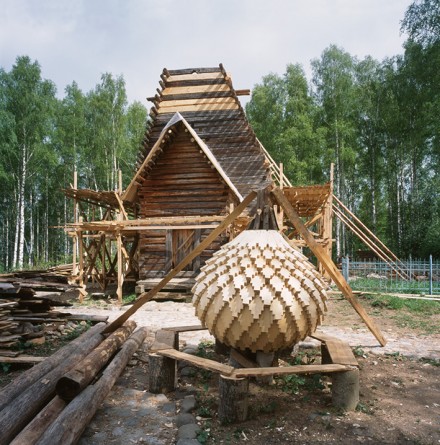
Wooden Church Eternal Peace 16th May 2009
Plyos is beautifully situated on the steep bank of the Volga River. The name comes from the word plyos that denotes a straight length between two turns of a river. The town was founded in 1410 by Vasily I, the Prince of Moscow and the son of Dmitri Donskoi.
Levitan spent three summers here in 1888, 1889 and 1890. After the rain painted in 1889 is probably his most celebrated image of the town. Other famous visitors were Chekhov and Chaliapin.
From Plyos we set off to drive to Lake Udolmya. We take our time. My Google research had thrown up a few interesting facts, not least of which is that Lake Udomlya now plays host to the Kalinin Nuclear Power Plant. Knowing that Prime Minister Vladimir Putin had chaired a meeting at the Kalinin Nuclear Power Plant on the 15th April 2009 (23 years to the month after the Chernobyl disaster) and survived was reassuring. The press release issued by the Government of the Russian Federation containing the following conversation between Prime Minister Putin and the Head of the Kalinin Nuclear Power Plant Sergei Kiriyenkko removed any doubts we might have had about visiting the area.
Sergei Kiriyenko: As far as personnel exposure to radiation, you can see that the measurements indicate levels of zero radiation. Beginning in 2002 and 2003, the charts have shown no exposure to radiation, as such a condition does not exist at Russia’s nuclear power plants. Here, you can see a comparison chart between Russia and the world. The question on whether the nuclear energy in Russia is safe has been frequently raised.
Vladimir Putin: I heard that you have done some scuba diving here?
Sergei Kiriyenko: That’s right, I went diving here with the Governor.
Vladimir Putin: When was that?
Sergei Kiriyenko: Two years ago. There are a lot of fish here, by the way.
Vladimir Putin: Did you eat some?
Sergei Kiriyenko: We did, in fact; I highly recommend it.
Vladimir Putin: Very good.
Others have been equally satisfied with their visit to Udomlya as Oliver from Clear Lake USA testified to the Sincere perfect woman marriage web site (Sincere perfect woman. Make bookmark this marriage web site that is why as we’ll modifying this often) on the 10th August 1998 – I have had success quickly and thank you for genuine cupid marriage network. I should to date your funny ladies when I travel to Udomlya. I have met girlfriend from your community. Hopefully I must find the adventurous woman of my wishes here. Your agency is perfect quality network and again i want to thank you for your response.
Reading the Survey of the Parasites of Zebra Mussels (Bivalvia: Dreissenidae) in Northwestern Russia by Daniel P. Molloy, I. Vitali, Â A. Rotman, and Jeffery D. Shields and the study on the Detection of radionuclides in the shell of the freshwater molluscs by Michael A. Zuykov, Stanislav I. Shabalev, Viktor P. Tishkov, Andrey I. Smagin, Yulia V. Plotkina, Maxim R. Pavlov, Marina I. Orlova and Thomas Servais both produced by studying specimens found by the shore around the power station does little to dent our confidence as the report and conclusions are written in such gobbledegook that for us ignorance is bliss.
Our journey from Plyos to Udomlya, like any journey in Russia throws into our path moments which highlight the beauty and the tragedy of this extraordinary country.
In Kostroma a huge statue of Lenin with his right arm outstretched points to a future he could never imagine, no more than Nicholas II could have imagined the future when he came to Kostroma in 1913 to dedicate the foundation stone for a great monument in the city park that would honor 300 years of Romanov rule. At the dedication Nicholas II threw a handful of gold coins into the cement. The pedestal for the monument was finished and then on July  17th 1918 the Tsar and his family were murdered in the basement of the Ipatiev house in Ekaterinburg. Ten years later in 1928 J.V. Stalin sent a message to the workers of Kostroma – âFraternal greetings to the workers of Kostroma on this First of May, the occasion of the unveiling in Kostroma of a monument to Lenin, the founder of our Party! Long live the workers of Kostroma! Long live May Day! May the memory of Lenin live eternally in the hearts of the working class!â The Romanov pedestal and the Tsarâs gold were used to support the towering Lenin.
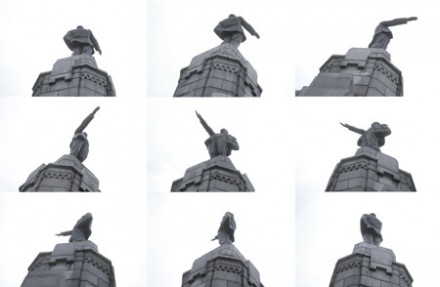
Kostroma Lenin 17th May 2009
In 1934 the Kostroma Kremlin together with the Assumption and the Epiphany Cathedrals were blown up by the communists. The Trinity Cathedral (1652) at the Ipatievsky Monastery survived and a service is taking place when we visit. An all male choir is singing gloriously; they drink tea and check their mobile phones when at ease. The interior walls are covered in beautiful frescos painted in 1684 by the Kostroma master, Guri Nikitin and his team of icon-painters. A magnificent five tiered gilded Iconostasis has also survived, made by the Kostroma woodcarvers Piotr Zolotariov and Makar Bykov in the 1750s.
In a village outside Kostroma a wing clipped Aeroflot aeroplane has landed in the garden of a small house and the Lenin Kolkhoz slowly disintegrates in the shadow of the Romanov Forest Hotel.
Between Ivanovo and Jaroslavl in the village of Osenevo we stop to photograph the stone Church of Kazansky Mother of God. The church was broken in the thirties and the bells were thrown from the bell tower. A man and his wife working in their garden tell Polina that the priest was sent away and died in prison and that all the communists who took part in the destruction of the church died of heart attacks. The cladding from the five onion domes has been stripped away by time; only the structural skeletons remain. A semblance of the pre-revolutionary village encircles the church, ducks and geese swim in the village pond, old wooden izbas are dotted around a rich green meadow and water is still drawn from a well.
At Jaroslavl we check into the Bears Corner (a quiet empty place in the forest rarely visited by man) Hotel – then drive to the village of Nikulskoye for supper at the Valentina Vladimirovna Tereshkova Cosmos Museum restaurant. Tereshkova was the first woman and first civilian to fly into space on the 16th June 1963. Her call sign was Chayka (Seagull). She orbited the earth 48 times and spent almost three days in space, which was more than the combined flights times of all American astronauts at the time. Her selection for the space program was shrouded with great secrecy. Tereshkova reportedly told her mother she was going to a training camp for an elite skydiving team. Her mother only learned she was a cosmonaut when the flight was announced on Radio Moscow. Sadly the food does not come in foil packaging and the drinks are not served in zero gravity flasks but at the end of a countdown the lights dim and the engines attached to the re-entry capsule decorating one end of the restaurant explode into life. Red lights flash, bits of flame shaped silk are wind machine blown to represent flames, smoke fills the restaurant, the waitress coughs, splutters and waves her arms frantically to clear a passage to the kitchen. From loudspeakers doted around the room there emanates a great rocket lift off noise which cross fades into the wonderful Stalinist anthem, sung no doubt by a major in the Red Army Choir -
We were born to make fairy stories come true
To conquer the boundlessness of space
Our reason has given us wings of steel (hands-wings)
And a heart like a fervent engine.
Higher and higher and higher
We guide the flight of our birds
And in every stroke of their wings
Our borders breathe in peace
As our compliant machine takes off
On its unprecedented flight
The promise of the worldâs first proletarian fleet
Is strengthened and fulfilled
Higher and higher and higher
We guide the flight of our birds
And in every stroke of their wings
Our borders breathe in peace
Our sharp gaze pierces every atom
Each nerve is shining with determination
And, believe us, our Air Force
Will give answer to every ultimatum!
Higher and higher and higher
We guide the flight of our birds
And in every stroke of their wings
Our borders breathe in peace
The smoke clears, the flame shaped silk stills, the house lights dim up â âHow was it for you Polina?â
We crawl from our Bears Corner as early as possible, the breakfast is not a patch on Private Visit in Plyos.
In Uglich we relive a pivotal moment in the history of Russia and of Russian Opera. The tragic story of Tsarevich Dmitri (1582 – 1591) is the basis of Modest Mussorgskyâs wonderful opera Boris Godunov based on Pushkinâs drama of the same name. Dmitri was the son of Ivan the Terrible and Maria Nagaya . After the death of Ivan IV, Dimity’s older brother, Feodor I, ascended to the throne. However, the real ruler of the Russia was Feodor’s brother-in-law, a boyar Boris Godunov. Godunov wanted to get rid of Dmitri, who was the legal successor to the throne in light of Feodor’s childlessness. In 1584, Godunov sent Dmitri, his mother and her brothers into exile to the Tsarevich’s appanage city of Uglich. On May 15, 1591, Dmitri died from a stab wound, under mysterious circumstances. Pimen the Chronicler in Pushkinâs drama tells what happens -
âThen to the distant Uglich I was sent
On a certain mission. I came late at night.
Next morn, before the hour of service,
I hear a sudden toll – they sounded the alarm, -
Noise, shouts. People rush to the Princeâs yard.
I hurry with them – all the town is there.
I see: there lies the prince, his throat cut,
His mother – Queen beside herself with grief ,
His wet-nurse howls wildly in despair,
And people in anger drag across the yard
His nurse – the godless traitor…
Then among them, severe, pale with rage,
There appears the Judas – Bityagovski.
âHere, hereâs the villain,â – was a common shout,
And in a moment – he was no more….
Prince Vassili Shuyski was sent to Uglich to investigate the killing of Dmitri. The consequence of which as so often in Russian history was more killing, torture and exile.
A false Dmitri occupied the throne after Godunovâs death. He didnât last long.
Along the embankment things are more peaceful – three young men mobile phones in hand are listening to the powerful song of a nightingale. We spot it in a tree, a tiny bird, itâs mouth wide open, itâs throat pulsating throwing out an extraordinary sound. We had thought the listeners were recording the song on there mobiles, in fact they were playing their ring tones which they hoped the nightingale would mimic.
Yodel would be a challenge Marimba a doddle.
The weather is sunny and fresh. The blue sky is dotted with fluffy clouds. The meadows are springtime green as are the growing leaves of the birch trees. Bird Cherry blossom highlights the landscape. The rivers and streams are full to overflowing. Fields are being prepared for sowing and cattle are grazing. The countryside looks extraordinary. The villages are generally well kept although we note a surprising number of burnt out izbas. In one village the fire has flattened and blackened a swath of buildings. In another the old kolkhoz buildings are in ruins. A standing wall has the exhortation Glory to work picked out in red brick.
At the village of Archangelskoye (formerly, we later learn, Archangelskoye Mikhail) we stop to photograph another broken church. The church is on two levels, the winter church on the ground floor, Â the summer church on the 1st floor. Murals decorate the walls and ceilings where the plaster is still attached to the lath, but much has fallen or been defaced by graffiti. Amongst the desolation of the ground floor there are cheap icons pinned to the wall and candle stubs pushed into the now earth floor. The stairs to the first floor have disappeared but we scramble up and make our way into the summer church walking on the huge floor joists, the iconostasis remains sans icons and is daubed high up at tier four with the word Communist! Elsewhere there are pledges of eternal love to Lara, Olga, Lena, Zina, Katya, Natasha and Tatyana.
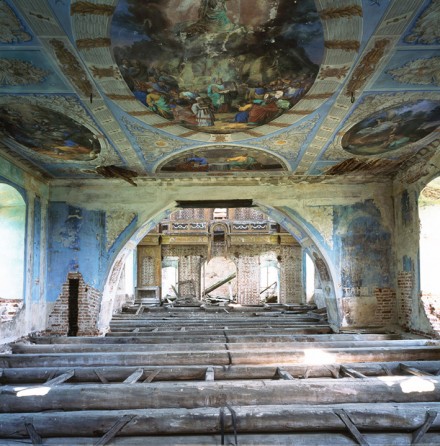
Church of Archangel Mikhail 18th May 2009
Outside I find an old 78 rpm Melodya record of Sergei Mikhalkov reading one of his famous children’s stories âUncle Steepleâ. While I have been taking photographs Polina has been trying to track some body down to tell us about the church but the village is deserted and the shop boarded up. As we are about to leave we see Raiisa Mihailovna Sokolova walking along the road towards us hand in hand with her sixty odd year old son. She is happy to tell us all she knows. The church was broken in the late fifties when the Kolkhoz was set up and the priest sent away. The walls surrounding the church and its magnificent portal were taken down so that the bricks could be reused. Although Raiisa describes herself as a bezbognitsa, a woman without faith, she tells us that when the church was functioning she took a great interest in the goings on. This she kept to herself, she was employed in the library by the local administration and would have been fired if her interest had become known. The church served many of the surrounding villages and Raiisa remembers seeing weddings, baptisms and funerals. She told how on one occasion the priest came to the library and proposed that she drink with him â what will the cleaner think?â the priest invited the cleaner to join them. Raiisa tells us the cleaner became very drunk but that she remained sober.
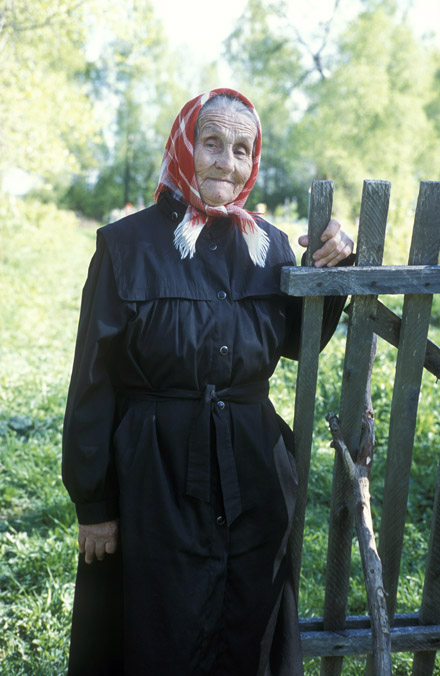
Raiisa Mihailovna Sokolova 18th May 2009
The village was thriving, it was an important local centre with a population of 1,700 people, there was a school (it closed last year, her daughter taught there), an old peoples home, a hospital and a club for dancing, films and wedding celebrations. The population is now 4, her son, another single man and an old couple, all retired. Raiisa lives with her daughter, the teacher in a neighbouring village. The shop closed recently because of a lack of customers and a surplus of thieves.
This year Easter (Paskha) was celebrated in the church by a priest from another place. As is the tradition in the Russian Orthodox Church, at midnight the congregation, holding lighted candles, processed around the church.
Raiisa then tells us of Ksenia Stritsa, a religious lady from a rich family who was able to foretell the future. She lived from 1842 until 1940 and her fame is such that people still come to visit her grave in the village cemetery. Raiisa invites us to visit the grave. Still hand in hand with her son she walk slowly through the village and points out the the site of the hospital, her library and where her son now lives. As we approach the graveyard in the forest she talks of eternal peace. Ksenia Stritsaâs grave is well kept and colourfully amassed with plastic flowers – the photograph attached to a cast iron cross shows a pleasantly stern old lady with her head covered by a large plain white babushka. Raiisa points out the graves of her other son who died in 2006 of an illness, of her father who died of old age and of her husband who died in 1945 overdoing his celebration of the Victory in the Great Patriotic War. As we say good-bye to Raiisa and her son we all acknowledge the happy coincidence of our meeting.
That evening we make it to Bezhetsk – Google comes up with the following information -
Bezhetsk: a city in Tverskaya oblast’, Russian Federation
Accommodation (0): There are no Accommodation entries for Bezhetsk. If you know of any, please add them now
Restaurants (0): There are no Restaurant entries for Bezhetsk. If you know of any, please add them now
Event Venues (0): There are no Event Venue entries for Bezhetsk. If you know of any, please add them now
Attractions (0): There are no Travel Attraction entries for Bezhetsk. If you know of any, please add them now
Transport (0): There are no Transport entries for Bezhetsk. If you know of any, please add them now
Other Facilities (0): There are no Other Facility entries for Bezhetsk. If you know of any, please add them now
Organisations: Our directory has no Organisation entries for Bezhetsk. If you know of any, please add them now
In fact there are three hotels in Bezhetsk. The Rus is full so we make do with the Prestige. Unfortunately they only have rooms available for four and three persons so the two of us pay for seven beds.
We eat at the Portal Night Club which we are happy to recommend, the clubbers played chess, the music was gentle and soulful and a patron very kindly offered to show me a good time. My present quest for Eternal Peace made this an offer I had, on this occasion, to refuse.
We crawl from our Prestige beds as early as possible, the breakfast is not a patch on The Bears Corner in Jaraslavl.
Another beautiful day; the final day of our journey. There is no sign of the lowering Levitan sky as we approach Udomlya. Weâve been landed with ‘a jolly nice spring day’. Olga by the Volga had told Polina that Udomlya was a city closed to foreigners so Iâm a bit nervous as we approach the town. A few years ago I was interrogated for a couple of hours and then fined a few thousand roubles having unknowingly stopped for lunch in Plesetsk, the home, it turned out, to one of Russiaâs Intercontinental Ballistic Missile sites. So no lunch. We skirt the town and make for the north end of the lake away from the nuclear facilities. Polinaâs GPS navigation device which has been a great help up to now comes up with no roads although our small scale map of the Russian North suggests there are some.
At the north end of the lake we spot a large stone monolith standing on a small rise. On closer inspection we see that there is a plaque attached to it celebrating the lives and talents of the artists who had painted here in the past. Levitanâs name is inscribed, we are in the right place. It is beautiful. The rise is awash with dandelions, the lake sparkles, ducks crash land in the water, wooded islands fringed with rushes dot the lake, two huge cloud making cooling towers sit on the horizon and little white clouds scud across the blue sky; more What a Great Day to be Alive than the pleasurable melancholy of Above Eternal Peace.
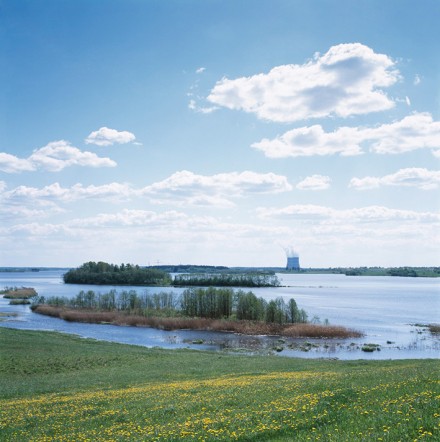
Lake Udomlya 19th May 2009
We arrive back at Polinaâs Moscow kitchen around 9.30pm just in time to watch the sun dip behind the Kremlin.
>{}<
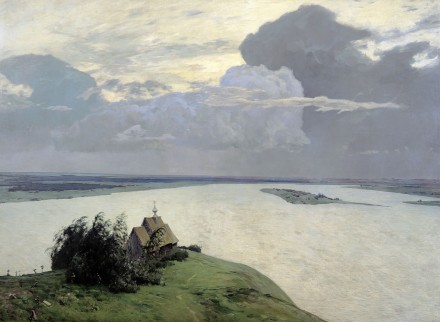
September 6th, 2010 at 3:24 pm
The story “Search for Eternal Peace” is. very interesting. Where we can find the eternal quietness? I have felt something look like quietness on Soloveckij archipelago in the White sea, where is priory of the Transfiguration. Richard, thank you for the enormous and important work! Here are plenty of left temples in Russian North. I know that there is island Whitsunday (Troica) in the Belomorsk administrative region, there is wooden priory. The people sail on boat to this island much seldom since it was hidden in wood. My friend travelled there – http://olegu.narod.ru/karsakov2.html The journey there is a big adventure.
September 29th, 2010 at 9:30 am
Wow! Wooden Church is great!
July 27th, 2024 at 5:28 pm
print to mail service…
Save now the best Best Post Card that is this week available and currently available this week only!…